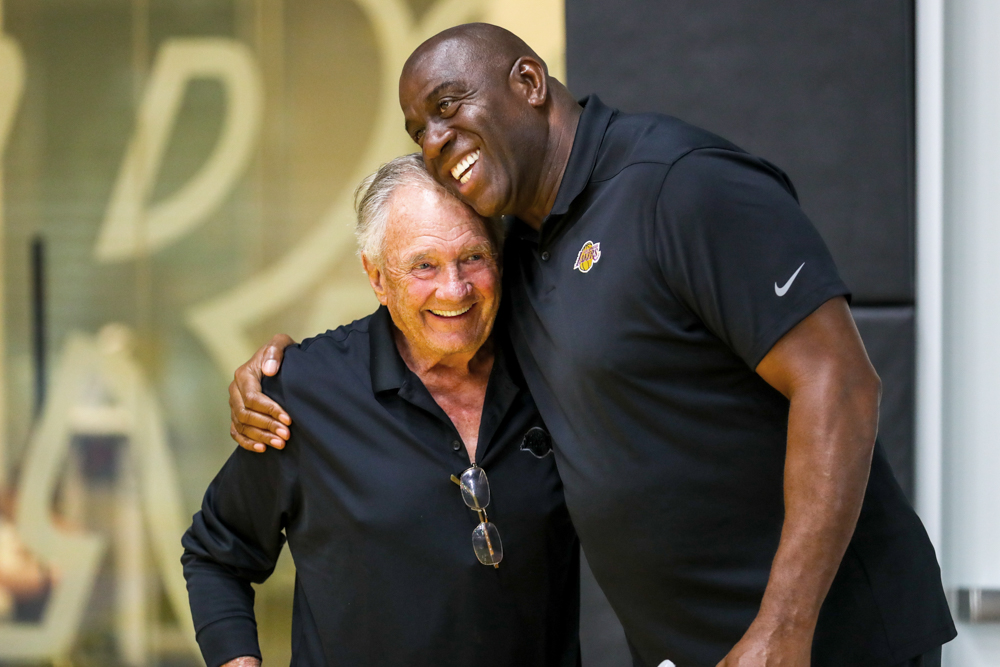Bill Bertka’s Beautiful Life
91 Years of Hard, Happy Work, from Santa Barbara City Hall to the L.A. Lakers
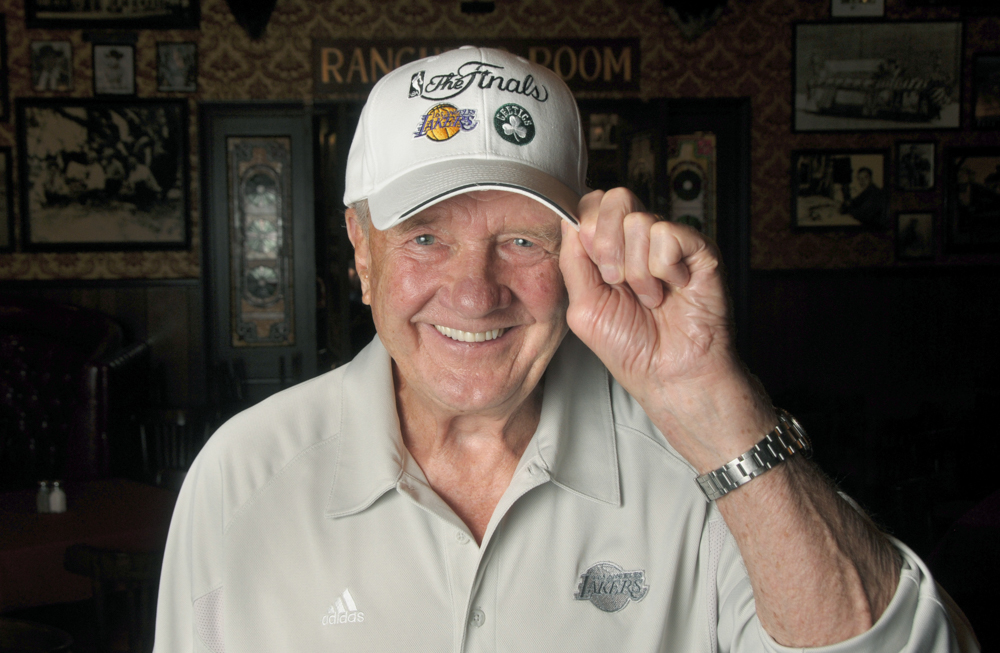
When Bill Bertka comes up with an idea, it’s worth hearing him out. His ideas about recreation and sports are manifest all over Santa Barbara. His basketball concepts helped create Showtime (the Lakers of the 1980s) in Los Angeles. At 91, he still boomerangs to L.A. as “special assistant and consultant” for the Lakers, but he remains rooted in Santa Barbara, his home for almost six decades.
Bertka wanted to talk the other day about the downtown stretch of State Street, with all its empty storefronts. “You’ve got sports bars; why not have a sports hall of fame?” he asked. He brought three pages of notes, listing various cities that put their athletic heritage on public display. The Virginia Sports Hall of Fame in the town square of Virginia Beach comprises exhibits in different offices and lobbies, connected by a pedestrian tour called Walk the Hall.
“All the vacant spaces on State Street, turn it over to nonprofit; you’re going to get a tax write-off on the property,” Bertka said. “Halls of fame stimulate interest in the community. When these boats come to Santa Barbara and bring people up State Street, have something of interest. Put athletes’ stars on State Street like in Hollywood. They’re paying consultants thousands of dollars to get some ideas. These are free.”
Bertka had an official voice in civic projects when he was the city’s recreation director from 1961 to 1972. He promoted a myriad of activities. “We had fitness classes called the Huff and Puff program at Dwight Murphy Field,” he said. “We started volleyball in the afternoon on the beach. We had exercise for mothers at Cabrillo Pavilion; they could bring their babies. We started flag football down at Chase Park; all the elementary schools had teams, and they played on Saturdays. We had the Walk for Life program on the beach in conjunction with the American Heart Association. It was called cardiovascular conditioning.”
Bertka had the recreation department take over an art show in De la Guerra Plaza. “A guy by the name of Robert Eischen originated it,” he said. “We moved it down to the beach because of the space down there. There was all kinds of criticism. ‘You’re ruining the beach!’ Now people think [the Santa Barbara Arts and Crafts Show] is one of the greatest things. It’s not only popular from that standpoint, but it gets people out walking; it promotes activity.”
Another venture was the restoration of the Carrillo Street Gym. “It was a storage facility in 1961,” Bertka said. “I got them to turn it back into a gymnasium.” But there was pressure from City Hall to pull other properties out of recreational use. The most significant casualty was Laguna Park, a downtown baseball park that was a former home of Mets and Dodgers farm clubs. It was demolished in 1970, the site turned into a storage yard.
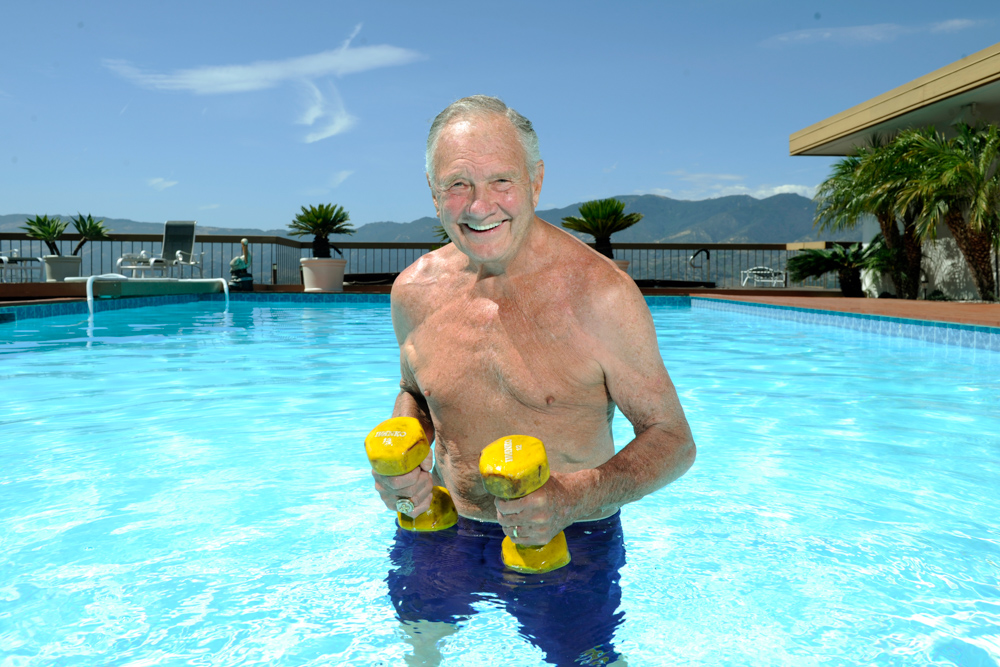
“The loss of that facility really hurt us,” Bertka said. “It was the home of our youth baseball program. It wasn’t under the rules of Little League baseball. Our city-run baseball program was: Everybody plays. Show up and you get on a team. Even Pearl Chase opposed tearing down Laguna Park.”
With the support of recreation commissioners Jerry Harwin and Caesar Uyesaka, Bertka said “three big things” were accomplished during his tenure: “One, the development of Shoreline Park. Two, they got the dump shut down, and Las Positas was dedicated to be a park in the future. Three, a joint use agreement between the City of S.B., City College, and the Harbor Commission for the use of facilities on the beach: Los Baños del Mar, La Playa Stadium, Pershing Park.”
One of Bertka’s most fruitful ideas was to start a weekly press luncheon conducted by the Santa Barbara Athletic Round Table, a nonprofit community sports organization founded by Harwin and Uyesaka. The first luncheon took place at Harry’s Plaza Café in September of 1970, and they still go on to this day.
Bertka grew weary of seeing recreation getting short shrift from city leaders. “It was low man on the totem pole,” he said. “The biggest culprit of all [on the city council] was Gus Chavalas. He was a killer. I saw the handwriting on the wall, how they were treating recreation. I advocated nonprofit foundations. I said that’s the only way recreation’s going to survive. It’s interesting what’s transpired. All the sudden [Las Positas Park] is Elings Park, run by a foundation.”
Bertka made a fast break from his city job to the National Basketball Association. The Lakers hired him as the first full-time scout in league history. It was one of many milestones that he achieved in the sport of hoops, beginning in his Ohio hometown.
The Coach’s Path
AKRON: It’s the birthplace of LeBron James, the newest Laker, and Bertka, the oldest. He played on the Buchtel High team that won a city basketball championship in 1945. It was at the Akron YMCA that Bertka developed his love of the sport. “I don’t know what would have happened to my life without it,” he said. “We were a poor family. They had open gym that cost five cents. I’d go shoot baskets at the Y. There were grown-up players there. George Glamack [a two-time All-American from North Carolina] taught me the hook shot.”
Bertka’s father worked “his whole life” for the Firestone Tire and Rubber Company. “He dropped dead of a heart attack at 60” — which surely influenced Bill’s health concerns.
MIDLAND: Bertka went into the U.S. Army out of high school and then had an opportunity to play basketball at Kent State University. He graduated with the ambition to coach. He wanted a head coaching job, and he learned there was an opening at Midland School in the Santa Ynez Valley. Without ever having set foot in California, he agreed over the phone to take the job at the start of the 1952-53 school year.
“I drove Route 66 and then up the coast,” he said. “I stopped at a Santa Barbara coffee shop. Where is this school? Go over the pass to Los Olivos. I saw the valley. Holy cow, what a place. Everything was brown. Los Olivos was a flagpole, a post office, and a gas station.”
Upon arriving at Midland, he found there was no gym — just a barn with dangling hoops — no uniforms, and nobody in its student body of 69 boys who played much basketball.
Bertka frequently visited Santa Barbara — “I used to coast down from the pass to save gas” — and befriended Jim Campbell, owner of All-American Sporting Goods. He introduced Bill to Solveig Ogren, a Swedish beauty whose father was working on the Tecolote Tunnel through the mountains.
HANCOCK: While coaxing the Mighty Oaks of Midland to learn the fundamentals of basketball, Bertka played some with the Golden Dukes, an Industrial League team in Santa Maria. In 1954, the city opened Allan Hancock College, and Bertka was hired as the school’s first basketball coach and athletic director. During his three years there, the Bulldogs put together a 41-game winning streak and won the state community college championship in 1957.
Bertka went to the Midwest to recruit players. Solveig accompanied him on a recruiting trip in 1956. “We got married in Liberty, Indiana, before a justice of the peace,” Bertka said. “It’s been 62 years. The key is to be able to get along.”
KENT STATE: Bertka’s alma mater, impressed by his work at Hancock, hired him to coach the Golden Flashes. “I had mediocre success playing the best teams,” he said. He couldn’t beat them in the recruiting game. “I had verbal interest from Bobby Knight and John Havlicek,” he said. “They were local high school kids. But they decided to go to Ohio State. I decided to leave after four years and start a new career. I told my wife we were going to go where we want to spend the rest of our lives, a place where people try to spend a vacation two weeks a year. Luckily, luckily, luckily, the Santa Barbara recreation job was open.” With their young daughters, Britt and Kris, the Bertkas moved west for good.
Welcome to the Pros
THE LAKERS, PART ONE: During his years as recreation director, Bertka started a college basketball scouting service known as Bertka Views, employing a network of scouts around the country. (Solveig later took it over and ran the service until videos supplanted its use in 1991.) He did some scouting himself for the Lakers. Broadcaster Chick Hearn enjoyed calling him “Tonto.”
That evolved into a career with the Lakers during which he would collect 10 NBA championship rings. The first was in 1972, when Bertka was assistant to Bill Sharman with a team that rattled off a 33-game winning streak, a professional sports record.
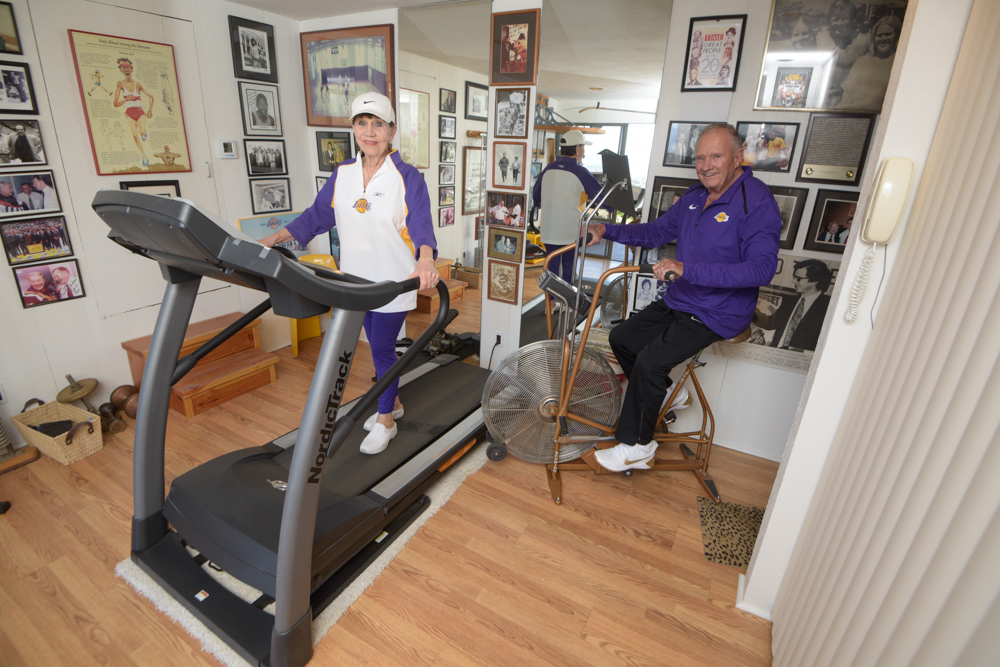
Those Lakers featured a high-scoring backcourt of Jerry West and Gail Goodrich. A player Bertka took a liking to was Pat Riley. “I always admired him,” Bertka said. “I said, ‘Pat, you are the most intense competitor I’ve ever seen. You aren’t getting much playing time, but you’re busting your ass in practice. I hold you as a great example of your profession.’”
NEW ORLEANS: Sam Battistone, a Santa Barbara entrepreneur, was the initial owner of the New Orleans Jazz in 1974. He prevailed on Bertka, a good friend, to be the director of basketball operations for the new franchise. “That six years was a very tough period of time for me and my family,” said Bertka, who commuted across the country. “It was a great moment when Bill Sharman called me in 1981 and wanted me to come back to the Lakers.”
The Jazz struggled on the court, as injuries hampered star player Pistol Pete Maravich. They made some deals that did not turn out well, including a trade that brought Gail Goodrich to New Orleans. The NBA determined that the Jazz should compensate the Lakers two years later with their first pick in the 1979 draft. That pick, the first overall, turned out to be Magic Johnson. “We didn’t plan on finishing last,” Bertka said, but it became his good fortune in L.A. that they did.
THE LAKERS, PART TWO: In 1980, Pat Riley was pulled out of the announcer’s booth to be the Lakers’ assistant coach. The next year, he was named head coach and tapped Bertka, who had returned to the club after his New Orleans stint, as his top assistant, calling him “the administrator of all things.”
“Bill took interest in me as a player, making sure I was in great shape,” recalled Riley, the president of the Miami Heat, in a phone interview. “I wanted to be the best-conditioned athlete. I won all the miles Sharman made us run. Bill and I would work out together. That’s why he’s 91.”
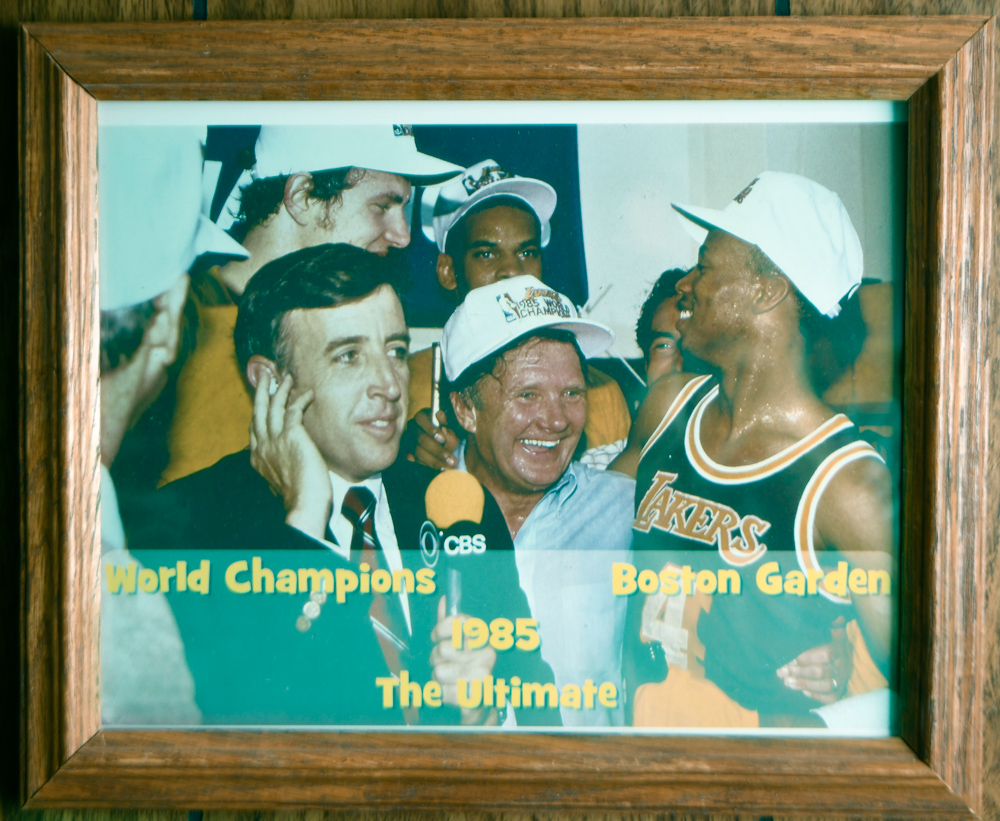
Bertka quickly became a “really great mentor and resource,” said Riley, who didn’t have any head coaching experience. “It was just Bill and I at first. We talked about fast-break options. When it came to running, nobody was like us. We went to the Finals nine times in 12 years.”
“We had a hell of a run,” Bertka said. “I still say that to this day the Lakers of the ’80s were the best basketball team ever assembled. They ran not for 20 minutes in a game, not for 30 minutes in a game; they ran and pushed the ball for 48 minutes in a game. That’s who the Lakers of the ’80s were. Not one guy running, not two guys running; all five guys ran. Defend, deflect, steal, rebound — every time we got possession, it was a fast-break opportunity.”
“It wasn’t a random fast break,” Riley said. “Magic [Johnson] was the maestro. [Kurt] Rambis was our enforcer/rebounder. He was a great outlet passer. Get the ball to Magic in one second or two. Magic had the ball four seconds: basket.”
Explained Bertka, “Somebody was flying up the floor to get the ball. Byron Scott, James Worthy, A.C. Green …. If nothing materialized on the first thrust up the floor, now here comes Kareem [Abdul-Jabbar].”
“Everybody had a role,” Riley said. “Bill kept the chart with the result of every single possession. We had a real sophisticated statistical system to evaluate players on a plus-minus basis.”
At Riley’s side, Bertka celebrated five NBA titles, highlighted by their taking down the nemesis Boston Celtics in 1985. He was more in the background as director of scouting when the Lakers won five more titles under Phil Jackson. All told, he has worked with 15 different head coaches in L.A. He filled in as an interim coach on three occasions. His record: 2-1.
Happy Home Life
Britt Eyen, who is married to basketball coach Jim Eyen, now a scout for the Minnesota Timberwolves, was a teenager when her dad was going back and forth to New Orleans. “He looks back on it as being more difficult than I did,” she said. “He was a very big presence whether in the same house or miles away. My mother put in long hours when he was away. Nobody in our family shies away from hard work.”
Besides his work ethic, Britt said her father’s biggest impact on her came from “watching the way he treats people. I’ve never seen him big-time somebody. He never fails to greet the people who work in the hotels he stays in or the workers who pick his avocados.”
When he’s home at his avocado ranch on Campanil Hill, Bertka stays in shape by exercising in the backyard pool. He has gotten around town to see how the city recreational facilities are coming along under Jill Zachary, the director since 2015. He is gratified to see that an upgraded Pershing Park has become the home of the Santa Barbara Foresters, managed by Bill Pintard, who is married to his younger daughter, Kris.
At the other end of the waterfront, Cabrillo Ballfield underwent a major facelift this year. “It’s beautiful,” Bertka said. “[Zachary] is doing some very interesting things. Now the Cabrillo Pavilion is being renovated. It’s a great concept. When you have existing facility, fix it up.”
He goes to work three days a week for the Lakers. It’s his 38th consecutive season with the team. “Every once in a while, I do some work with guys on the floor, do some scouting, whatever they want,” he said. “To me there’s no greater feeling, especially at this stage of life, than doing something meaningful. I haven’t set the world on fire, but I feel pretty good about my life.”
